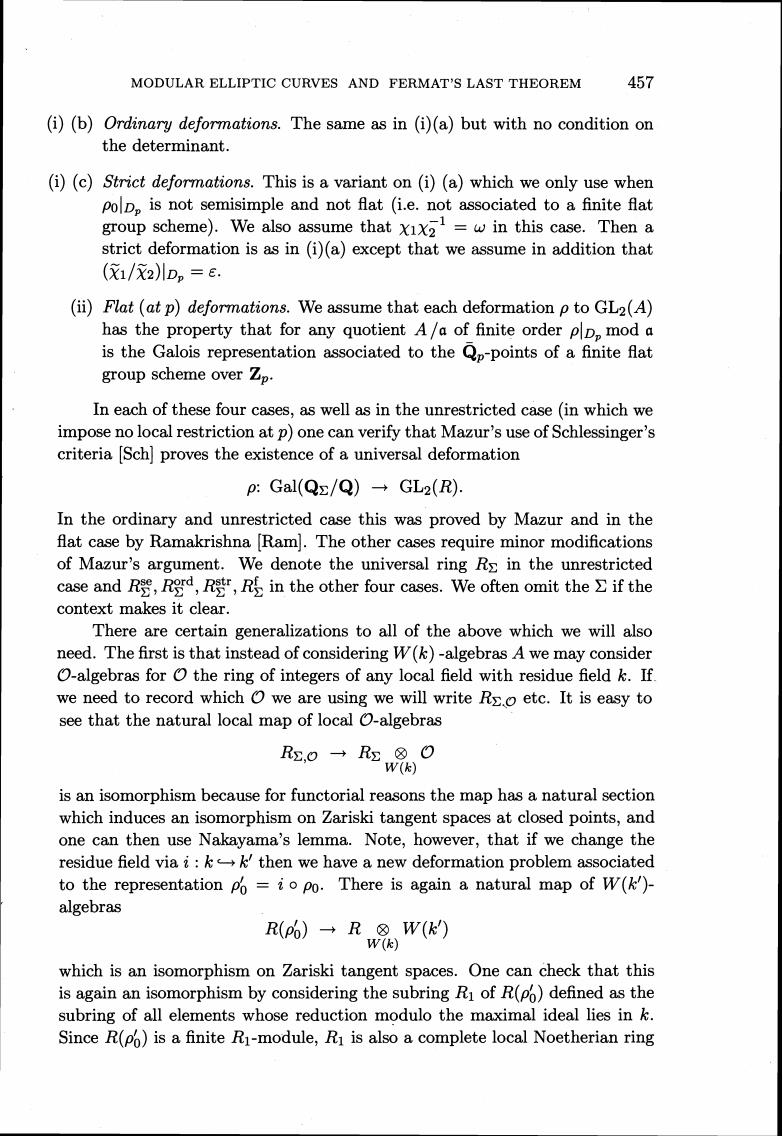正在加载图片...

MODULAR ELLIPTIC CURVES AND FERMAT'S LAST THEOREM 457 (i)(b)Ordinary deformations.The same as in (i)(a)but with no condition on the determinant. (i)(c)Strict deformations.This is a variant on (i)(a)which we only use when aenmo strict deformation is as in (i)(a)except that we assume in addition that (1/2)lDp=e. (ii)Flat (at p)deformations.We assume that each deformation p to GL2(A) has the p roperty that for any quotient A/of finite order mod is the Galois representation associated to the Qp-points of a finite flat group scheme over Zp. In each of these four cases,as well as in the unrestricted case(in which we impose no local restriction at p)one can verify that Mazur's use of Schlessinger's criteria [Sch]proves the existence of a universal deformation p:Gal(Q/Q)GL2(R) In the ordinary and unrestricted case this was proved by Mazur and in the flat case by Ramakrishna [Ram).The other cases require minor modifications of Mazur's argument. We denote the universal ring Rs in the unrestricted case and Rse,Rord,Rs,R in the other four cases.We often omit the if the context makes it clear There are certain generalizations to all of the above which we will als need.The first is that instead of considering W(k)-algebras A we may consider O-algebras for the ring of integers of any local field with residue field k.If. we need to record which we are sing we will write Ro etc.It is easy to see that the natural local map of local O-algebras is an isomorphism because for functorial reasons the map has a natural section which induces an isomorphism on Zariski tangent spaces at closed points,and one can then use Nakayama's lemma.Note,howey ver,that if we change the residue field then we problem iat to the representation po =io po.There is again a natural map of W(k)- algebras which is an isomorphism on Zariski tangent spaces.One can check that this is again an isomorphism by considering the subring R of R(p)defined as the nents whose reduction modulo the maximal ideal lies in k. Stemdulee octhrMODULAR ELLIPTIC CURVES AND FERMAT'S LAST THEOREM 457 (i) (b) Ordinary deformations. The same as in (i)(a) but with no condition on the determinant. (i) (c) Strict deformations. This is a variant on (i) (a) which we only use when polDp is not semisimple and not flat (i.e. not associated to a finite flat group scheme). We also assume that XIX;l = w in this case. Then a strict deformation is as in (i)(a) except that we assume in addition that (21122)ID, = E. (ii) Flat (at p) deformations. We assume that each deformation p to GL2(A) has the property that for any quotient Ala of finite order plop mod a is the Galois representation associated to the Qp-points of a finite flat group scheme over Zp. In each of these four cases, as well as in the unrestricted case (in which we impose no local restriction at p) one can verify that Mazur's use of Schlessinger's criteria [Sch] proves the existence of a universal deformation In the ordinary and unrestricted case this was proved by Mazur and in the flat case by Ramakrishna [Ram]. The other cases require minor modifications of Mazur's argument. We denote the universal ring Re in the unrestricted case and RE, RF~,Rgr,R: in the other four cases. We often omit the C if the context makes it clear. There are certain generalizations to all of the above which we will also need. The first is that instead of considering W(lc) -algebras A we may consider 0-algebras for 0 the ring of integers of any local field with residue field lc. If we need to record which 0 we are using we will write etc. It is easy to see that the natural local map of local 0-algebras is an isomorphism because for functorial reasons the map has a natural section which induces an isomorphism on Zariski tangent spaces at closed points, and one can then use Nakayama's lemma. Note, however, that if we change the residue field via i : lc ~tk1 then we have a new deformation problem associated to the representation pb = i o po. There is again a natural map of W(k1)- algebras which is an isomorphism on Zariski tangent spaces. One can check that this is again an isomorphism by considering the subring R1 of R(p6) defined as the subring of all elements whose reduction modulo the maximal ideal lies in lc. Since R(pb) is a finite R1-module, R1 is also a complete local Noetherian ring